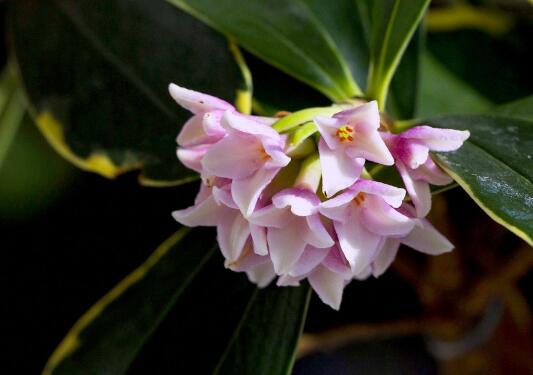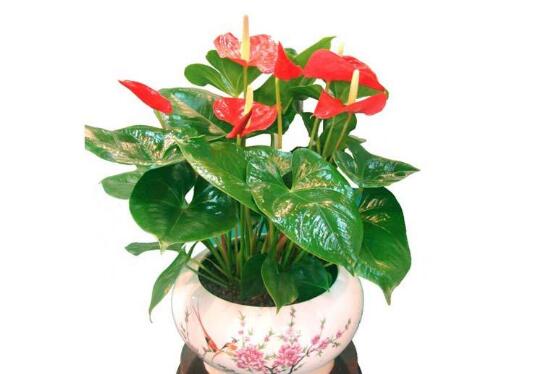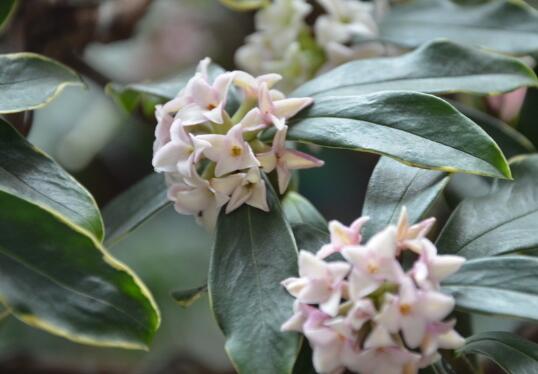How to raise Phnom Penh Daphne, the breeding methods and precautions of Phnom Penh Daphne / avoid strong light
Phnom Penh Daphne is a traditional famous flower in China, and it is also very well-known in the world, and it can be seen in many parts of the world. However, it is not easy to raise it well, and there are a lot of things to pay attention to. About how to raise Daphne odora in Phnom Penh? What are the breeding methods and precautions of Daphne odora in Phnom Penh? Next, the editor will take you to learn about it.
First, how to raise Daphne odorifera in Phnom Penh and understand their habits

If we want to know how to raise Phnom Penh Daphne, we must first understand its growth habits. This kind of plant likes semi-shade, but it should be placed in a sunny environment in spring and winter. in addition, we are also very particular about watering and fertilizing when we breed. The details are shown below. Let's take a look.
II. Culture methods and matters needing attention of Daphne odora in Phnom Penh
1. The soil has better drainage.
When we cultivate Phnom Penh Daphne, we first need to choose soil, which is a step to lay a good foundation. Generally, it is best to choose fertile, loose and acidic humus soil, which has good drainage and air permeability. It can be more conducive to its growth, and the soil with good drainage is not easy to cause stagnant water.
two。 Fertilization, once every 10 days during the growing period
Fertilizer is one of the main nutrients in the growth process of Phnom Penh, especially after it enters the growth period, the demand for fertilizer is very large, basically every 10 days need to be fertilized. However, one thing we should keep in mind when applying fertilizer is that the fertilizer must be diluted before it is applied so that the plant can absorb it. If the concentration of fertilizer is too high, it is easy to burn the plant.
3. Watering, control watering / avoid stagnant water
Phnom Penh's root system is fleshy, so we must control the amount of water when watering it at ordinary times, and remember not to water too much, otherwise it will easily cause root rot if it causes stagnant water. If you inadvertently water too much, you must clean up the excess water in time.
4. Light, keep in the scattering of sunlight / avoid strong light
Among the breeding methods and matters needing attention of Daphne odora in Phnom Penh, lighting is also a point that needs to be paid attention to. It likes semi-shade, but there can be no lack of light in the growth process, so we can put it in the outdoor sunlight scattering place when the light is more suitable in spring and autumn. When the summer light is relatively strong, we need to shade it so as not to sunburn the plant.
5. Trim, pick the heart and hit the top in time.
Phnom Penh Daphne is a plant with strong germination ability and resistance to pruning, so in order to maintain its plant type, we need to pick the heart and top it in time. And after its flowering, we have to prune the residual flowers, withered leaves and some dead branches to enhance the light transmittance of the plant.
6. Prevention and control of diseases and insect pests should be timely.
In the process of cultivating Phnom Penh Daphne, if we are not careful, it is easy to let diseases and insect pests enter. This kind of problem is extremely harmful to the plant, so we must deal with it in time, because the longer the time drags on, the more difficult it is to prevent and control, and the greater the harm to the plant will be. Specific prevention and control methods Xiaobian in Phnom Penh Ruixiang pest control article has been introduced in detail, you can understand.
Culture methods and matters needing attention of Daphne odorifera in Phnom Penh
Phnom Penh Ruixiang is a world-famous flower, beautiful and unrestrained, full of vitality, has been loved by people since ancient times, is a classic potted flower, then today Huinong net editor will teach you three simple tricks to easily raise Phnom Penh Ruixiang, bid farewell to yellow leaves!
Phnom Penh Daphne is a classic potted flower commonly seen in horticulture. It is not only a traditional famous flower in China, but also a famous flower in the world. Phnom Penh Daphne is famous for its color, fragrance, appearance and rhyme. Phnom Penh Daphne is a variety of Daphne odora, symbolizing auspiciousness. Deeply loved by the people, how to raise Daphne odora in Phnom Penh? Today, the editor of Huinong Network will tell you about the breeding method of Daphne odora in Phnom Penh.
The culture method of Phnom Penh Daphne:
1. Phnom Penh Daphne's requirements for soil:
When potted Phnom Penh Daphne should choose loose and fertile acidic soil. You can use mud or garden soil: peat soil: rotten leaf soil = 1:1:1, and then add a little base fertilizer.
2. The lighting requirements of Phnom Penh Ruixiang:
Phnom Penh Ruixiang like plenty of sunshine, but avoid hot sun exposure, winter, spring and late autumn should be placed in a sunny place, summer should be shaded or placed in a bright and ventilated place for maintenance.
3. The moisture requirements of Phnom Penh Daphne:
Phnom Penh Ruixiang root is fleshy, usually maintenance and management should pay special attention to control watering, such as too much watering, basin soil is too wet for a long time, easy to cause rotten roots. After the rain, the stagnant water in the basin must be poured out in time. After Frosts Descent, the water content of the basin soil should be controlled at about 45% in order to survive the winter safely.
4. Temperature requirements of Phnom Penh Daphne:
Phnom Penh Ruixiang bogey high temperature and hot, the temperature more than 25 ℃ to stop growing, summer should pay attention to cooling. It is not cold-resistant, so it should be moved indoors in winter and placed in a sunny place. The room temperature is kept above 5 ℃ to survive the winter safely.
5. Phnom Penh Ruixiang's requirements for fertilizer and water:
Ruixiang prefers fertilizer, but it should stop fertilizing in the hot summer to avoid causing fertilizer damage. Sufficient base fertilizer was applied in early spring combined with changing pots, and liquid fertilizer was applied every 10 days during the peak growth period in spring, mainly nitrogen and potassium fertilizer in spring, phosphate fertilizer after autumn, and foliar spraying of potassium dihydrogen phosphate every week after flower bud formation.
6. Common insect pests of Daphne odora L. in Phnom Penh:
The main pests harmful to Phnom Penh Daphne are aphids and shell insects, which mostly appear in the dry and hot climate and should be controlled as soon as possible. The disease is mainly caused by virus mosaic disease, infected plant leaves appear color spots and deformities, poor flowering and growth stagnation, should be found to root out and burn with fire.
7. Pruning of Daphne odora in Phnom Penh:
Phnom Penh Daphne is resistant to pruning, so it should be pruned after flowering, cut short the branches that have bloomed, cut off the overgrown and overlapping branches, and cut off the crossed branches and overdense branches, so as to strengthen the ventilation inside the plant and keep the plant shape beautiful. When new buds sprout, the overdense branches should be pruned to enhance the internal permeability of the plant.
Notes and common problems in Phnom Penh Daphne culture
1. Soil alkalinity: Phnom Penh Daphne likes slightly acidic soil. Attention should be paid to the problem of soil alkalinity in the process of culture, and ferrous sulfate can be applied regularly to improve soil acidity and alkalinity.
2, the sun is too strong: summer Phnom Penh Daphne should avoid strong light, can be placed in the place of scattered light maintenance, too strong sunlight is easy to cause leaf burns.
3. The temperature is too low: Phnom Penh Daphne is not resistant to freezing, and it should be kept above 0 ℃ at least in winter, otherwise it is easy to freeze. In winter, we should pay attention to heat preservation and give sufficient light.
Phnom Penh Daphne is a classic potted flower with ornamental value and medicinal value. The above are the breeding methods and precautions of Phnom Penh Daphne, which can be collected by relatives who love flowers!
Summer Culture method of Phnom Penh Daphne 1. Summer watering
Phnom Penh Daphne should keep the soil dry in summer and spray water on the leaves of Phnom Penh to cool down. In addition, because of the large rainfall in summer, it is easy to leave stagnant water, so it is necessary to strengthen drainage treatment in time. Otherwise, once there is water in the basin, Phnom Penh incense will rot.
2. Summer pruning
Phnom Penh's summer pruning is through topping so that it can grow more branches and leaves, so as to maintain the growth and plant shape of Phnom Penh.
3. Shading and cooling
In order to achieve the cooling effect, we need to increase the humidity in the air, so we need to spray water on the leaves of the plant every day, and we also need to place the plant in a cool and ventilated place to avoid strong light.
4. Fertilization in summer
For Phnom Penh Ruixiang is very like fertilizer, but Phnom Penh Ruixiang does not like big fertilizer, so it needs to apply some thin fertilizer, but can not apply too much fertilizer, as long as enough nutrition.
- Prev

How to raise the flaming crane flower, the breeding method and matters needing attention / avoid direct sunlight
Crane flower is a kind of plant native to tropical South America, which was introduced to China. Nowadays, it can be seen in many parts of our country, and there are many people who raise it in our country. However, if we want to raise it well, we need to pay attention to many places. About how to raise crane flowers
- Next

How to raise Phnom Penh Ruixiang in summer, how to raise Phnom Penh Ruixiang in winter / summer shade / winter temperature control
Summer and winter as the two most contrasting seasons of the year, many plants do not adapt to their growth, and Phnom Penh Daphne is no exception. About how to raise Ruixiang in Phnom Penh in summer? How to raise Ruixiang in Phnom Penh in winter? There are a lot of things to pay attention to. Let's take you to know.
Related
- Fuxing push coffee new agricultural production and marketing class: lack of small-scale processing plants
- Jujube rice field leisure farm deep ploughing Yilan for five years to create a space for organic food and play
- Nongyu Farm-A trial of organic papaya for brave women with advanced technology
- Four points for attention in the prevention and control of diseases and insect pests of edible fungi
- How to add nutrient solution to Edible Fungi
- Is there any good way to control edible fungus mites?
- Open Inoculation Technology of Edible Fungi
- Is there any clever way to use fertilizer for edible fungus in winter?
- What agents are used to kill the pathogens of edible fungi in the mushroom shed?
- Rapid drying of Edible Fungi

